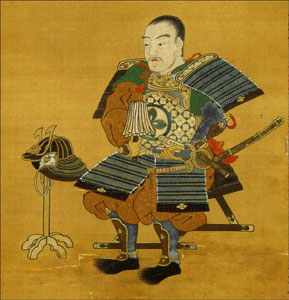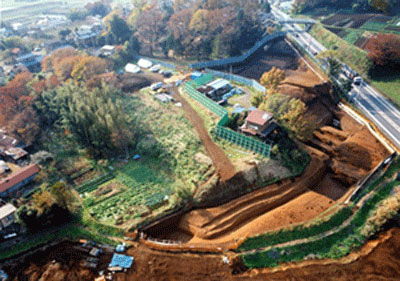公開日 2021年11月12日
Muromachi Period
Conflicts between the Uesugi Families & Ota Dokan

After the Kamakura shogunate was toppled by the uprising led by Ashikaga Takauji in 1333, the emperor Godaigo began governing Japan. However, many warriors were not content with his government which tried to restore the old imperial ways. Ashikaga Takauji, as the leader of the military clan, opened another government, attracting such unsatisfied warriors.
He placed the shogunate government in Kyoto and sent his son Motouji to the branch government placed in Kamakura to rule eastern Japan. Kubo, the title of the head of the branch government, was hereditary. As time passed, kubo became disobedient to the shogunate in Kyoto. The Uesugi family was appointed to assist kubo as regent in 1362. The regent was also a hereditary title and the Yamanouchi Uesugi family monopolized this job, though there were three other Uesugi families: Inugake, Takuma, and Ogigayatsu. Uesugi Akisada moved to live in Ogigayatsu in Kamakura from Tanba, Kyoto, and started the Ogigayatsu Uesugi family. His father was already in Isehara in charge of the Kasuya manor by 1351. In this way, Kasuya in Isehara was assumed to be connected to the Ogigayatsu Uesugi family.
The picture above is the portrait of Ota Dokan, painted in the Edo period. It has been kept at Daiji-ji Temple in Shimo-Kasuya and designated as a Municipal Cultural Property.
The fourth-generation kubo Mochiuji, head of the Kamakura branch government, confronted the fifth shogun of the Muromachi (Ashikaga) shogunate Yoshinori. Mochiuji also opposed the regent Uesugi Norizane, who made efforts to mediate between the two parties: the shogunate and the Kamakura branch government. The war broke out in 1438 and Mochiuji was defeated killing himself at Yoan-ji Temple in Kamakura in the following year. In 1440, warriors of the northern Kanto region led by Yuki Ujitomo assembled at Yuki Castle supporting the son of Mochiuji. Kuroda Motoki says Uesugi Mochitomo was able to become the lord of the Sagami province due to his distinguished achievement at this war. Ota Doshin was appointed his regent. The provincial office was placed in the Kasuya manor, which was owned by the Ogigayatsu Uesugi family. And thus, Kasuya became the base for the Ogigayatsu Uesugi family to govern the Sagami province. And thus, Kasuya became the base for the Ogigayatsu Uesugi family to govern the Sagami province. The Ota family assumedly had a house in Kasuya, too.
After Mochiuji killed himself, the seat for kubo was not occupied for a while. After the shogun Yoshinori was killed by his military general Akamatsu Mitsusuke, Mochiuji’s son Shigeuji was recognized as kubo, head of the branch government of the shogunate. However, the Uesugi families had a great antipathy to Shigeuji, and the army led by both the Yamanouchi and the Ogigayatsu Uesugi attacked the Shigeuji’s palace in Kamakura in 1450. They fought on the Yuigahama beach in Kamakura. Defeated, the soldiers of Uesugi fled to Kasuya. In 1454 the kubo Shigeuji killed his regent Noritada, the son of Kanezane, triggering the war which lasted the following 30 years. After Shigeuji moved his palace to Koga in the northern Kanto region, the two parties confronted each other across the River Arakawa.
In 1455, Uesugi Mochitomo left Kasuya to Hiratsuka, where a fierce battle broke out. The Uesugi was defeated and fled to Izu.
In 1457, Ota Doshin and his son Dokan built castles in Edo and Kawagoe moving the Uesugi’s base over there from Kasuya, Isehara.
In 1476, Nagao Kageharu raised a revolt against the Yamanouchi Uesugi over the post of minister. Ota Dokan took Kageharu’s fortresses in Aikawa, Atsugi, and Oiso. He suppressed the revolt finally by taking the last fortress in Chichibu in 1480.
In 1482, the Muromachi (Ashikaga) shogunate and its branch government (in Koga) were reconciled. Then the relation between the two Uesugi families became very delicate.
On July 26, 1486, Ota Dokan was invited by his master Ogigayatsu Uesugi Sadamasa to his house and killed there. Before this incident, Dokan had strengthened the Kawagoe and Edo castles, anticipating there should be conflicts between the two Uesugi families. In 1487, the next year, a war started in Shimotsuke (present Tochigi Prefecture) between the two Uesugi families. In 1488, Yamanouchi Uesugi Akisada attacked Kasuya with his 1,000 soldiers taking the Nanasawa fortress. To hear this, Ogigayatsu Uesugi Sadamasa came from Kawagoe with his 200 and some cavalry, fought a fierce battle on the field of Sanemakihara located between Atsugi and Isehara, and he narrowly won.
It is not known what happened to Kasuya after this in the Middle Ages. Recent excavations have revealed the remains of Maruyama Castle in Shimo-Kasuya. The castle is considered to have been built from the15th century to the early 16th century, and its large scale is especially noteworthy. It may be possible to say that this was associated with the provincial office of the Ogigayatsu Uesugi. However, this matter must be concluded after thoroughly studying Kami-Kasuya Uesugi Mansion site.

- Maruyama Castle in Shimo-Kasuya has a moat extending north to south crossing the National Route 246.
(by courtesy of Tamagawa Cultural Assets Research Center Ltd.)
Ise Sozui (Hojo Soun) and the Hojo’s Rule over the Kanto Region
In 1476, Ota Dokan went to the Suruga province to intervene in a dispute over the inheritance of the headship of the Imagawa family. After Imagawa Yoshitada died, there occurred a conflict between his son Ryuomaru and his cousin Norimitsu. Dokan supported Norimitsu because he was related to the Ogigayatsu Uesugi by blood. The dispute was settled thanks to Ryuomaru’s uncle Ise Shinkuro Nagauji, who was nicknamed the owl of the Age of Civil Wars. Later, he was called Hojo Soun. His achievements have been reassessed recently.
After he was given a castle by the Imagawa, he kicked Ashikaga Chachamaru out of Izu. Chachamaru was a son of the shogun’s brother Ashikaga Masatomo, who was sent to the Kanto region as kubo. After Masatomo died, Chachamaru killed his stepmother and his half-brother out of the family strife over the succession to the house in 1491. Soon after that, Soun gained control of the entire Izu province. He built a castle in Nirayama, which became the base of his maneuvering. He cooperated with the Ogigayatsu Uesugi to get Odawara Castle by driving away its lord Omori, who was supported by the Yamanouchi Uesugi. Soon Soun was separated from the Ogigayatsu Uesugi to proceed to the central Sagami province. In 1512, he attacked Okazaki Castle to drive Miura Dosun to his base in the Miura Peninsula. Miura Dosun and his son perished in 1516 at their Arai Castle. The Hojo grew to be the greatest feudal lord’s family in the Kanto region, passing the title to the second-generation Ujitsuna, who adopted the new family name Hojo, to the third generation Ujiyasu, and to the fourth generation Ujimasa.
Next⇒Civil War Period
- Geogaraphical Features of Isehara
- Paleolithic Period
- Jomon Period
- Yayoi Period
- Kofun (Tumulus)Period
- Nara Period
- Heian Period
- Kamakura Period
- Muromachi Period
- Civil War Period
- Edo Period
- Meiji, Taisho, and Showa Periods
Previous⇒Kamakura Period


